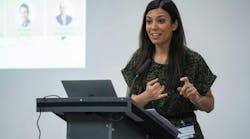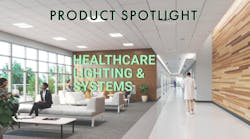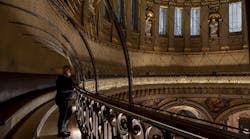EDITED BY CARRIE MEADOWS
The Lighting Quotient in West Haven, Conn., began as the design practice Sylvan R. Shemitz Associates in 1963, based in nearby New Haven. Founder “Sy” Shemitz is the father of current owner and CEO Allison Schieffelin. The Lighting Quotient has a long history as a family-owned business.
Shemitz invented the company’s Elliptipar products by combining an ellipse and two parabolas into a reflector system that could bend light rays and create an uniform light distribution on a horizontal or vertical plane. Hence, the birth of asymmetric architectural lighting. Manufacturing began in 1977 under the Elliptipar brand. In 2003, Shemitz decided to devote all the lighting design resources from the original practice to R&D of optical systems, light sources, and luminaires for professionals.
As a teenager, Schieffelin worked summers in the factory assembling fixtures. In adulthood, she became a member of the board of directors of Elliptipar and worked side by side with her father. In 2007, Schieffelin was named CEO of Elliptipar, which she would later rebrand as The Lighting Quotient. Vice presidents Zach Zaharewicz (design/applications), Paul Ford (product development), and David Pfund (research and product management) all launched their careers under Shemitz at the lighting design practice and carried over into the manufacturing business. Bill Mierzejewski, who has worked at the company for more than two decades in sales and development roles, is VP of sales.
Firm mission, in layperson terms: Schieffelin: To improve the choice of solutions for practitioners who care deeply about quality architectural lighting for human engagement and utility. We enhance the emotional connection between architecture and those who experience it, with a focus on visual comfort.
We are makers of luminaires that operate with high functionality and precise distribution. Our joy is bringing architecture to light.
The firm’s core values are an acronym LIGHT:
- Learn: To be avid students of new technologies and processes. To demonstrate true industry thought leadership.
- Innovate: To never copy or be copied. We seek out and embrace what has not been accomplished in architectural lighting.
- Grow: To target unserved and underserved markets with superior solutions in order to expand our business and secure our future.
- Honor: To respect and exemplify the legacy of our founder, we will only produce figures of uncompromising quality in construction and performance.
- Teach: To share what we learn with our contemporaries and heirs; show the highest regard for each individual in the way we work, act, and interact every day; and preserve our place among the elite in our business for generations to come.
What we are known for: Precision optics for lighting surfaces evenly no matter how broad or tall. We are known for using architectural planes (ceilings, walls, or ground areas) as the object of light and the source of light.
What people don’t know about us: How much we’ve grown over the last five years by acquiring Electrix Illumination fabrication equipment and IP, which expanded our in-house manufacturing capabilities and broadened our product offerings; and that we are the exclusive U.S. representative for German-engineered Meyer Lighting. We have been continuously reinventing ourselves.
The Lighting Quotient has been vertically integrating to further reduce our reliance on foreign parts. We represent one of the few companies that never went to any manufacturing overseas and stayed as a made-in-America organization, which is very important to me.
When appropriate, we can make the smallest form factors, but never when miniaturization translates into unnecessary and harmful glare. The selection criteria for new fixture designs always includes intense review of where we want light and where we need to eliminate viewing angles that will compromise human comfort.
We are equally diligent whether the application is solely utilitarian or, at the other end of the spectrum, purely for artistic effect. The intention of lighting is specific to the application, but every project requires visual comfort and deserves the highest quality. In a cost-cutting world, we are hyper-focused on only using the required amount of equipment, and often achieve better effects with fewer fixtures than necessitated with other available tools.
First commission (product or project): Our first commission was the Jefferson Memorial. The Elliptipar was invented because of the Jefferson Memorial.
Favorite project by our company and why: The Nelson Atkins Museum in Kansas City and The Harlem Hospital in New York are among my favorite projects. Both used fluorescent sources and were completed in my earliest years as CEO. We were asked to help create a true lantern effect whereby the selected façade elements could glow without any visible source. Now, at Nelson Atkins, we have the opportunity to upgrade our fluorescent fixtures to LED, which would drastically reduce energy consumption and improve the overall effect on the campus landscape.
What are you currently working on? Adding components to our line that allow flexibility both in the design process and in the field, maximizing choice and adaptability for our loyal specifiers. Also, our next-generation LED chip integration is almost complete; by this June, we will have all 90+ CRI fixtures with negligible lumen depreciation.
A lighting trend to leave behind: Tiny for the sake of being tiny, which usually results in too much glare from over-brightness.
A tool or product you want to invent: A material or tool for protecting LEDs and all fixture components to make our equipment thoroughly impervious to extreme hot and cold environments.
Advice to anyone interested in entering the lighting industry: Look up. Look around, wherever you are — a restaurant, gym, stadium, office, courtroom, laundromat, or airport. What is calming, bothersome, or stimulating about the environment? Lighting does that. If you want to create environments that enhance human experience with the physical world, then muster your whole passionate heart and dive into studying and experimenting in all the disciplines around the art and science of light, from physics to neurology, maker-culture, design development, and more. Be curious and humble. You may very well have the most fantastic and rewarding, exhilarating, and joyful career ahead.
Designers you admire: Jim Benya, Deborah Burnett, David Ghatan, Chip Israel, Charles Stone, and Paul Marantz are all at the top of my list for simultaneously being devoted to their own practices and also devoting limitless energy to continuing the education of up-and-coming professionals. Their lack of selfishness is inspiring: They share. They give advice. They teach. They do their own job so well.
Technology or product you admire: Casambi wireless technology, a widely applicable protocol. Casambi is a widely adaptable, low-energy Bluetooth technology. Along with other exciting advances in controls technology, I believe Casambi’s protocol generally will continue to have incredible growth.
Associations, committees, nonprofits, or mentorship programs that your firm participates in: IALD/LIRC, AIA, and IES. I also have a deep admiration for WILD (Women in Lighting + Design). We interact with students from Parsons School of Design and Penn State University, and we hold manufacturing visits with students throughout the year.
Visit The Lighting Quotient online
Follow our LinkedIn page for our latest news updates, contributed articles, and commentary, and our Facebook page for events announcements and more. You can also find us on Twitter.









